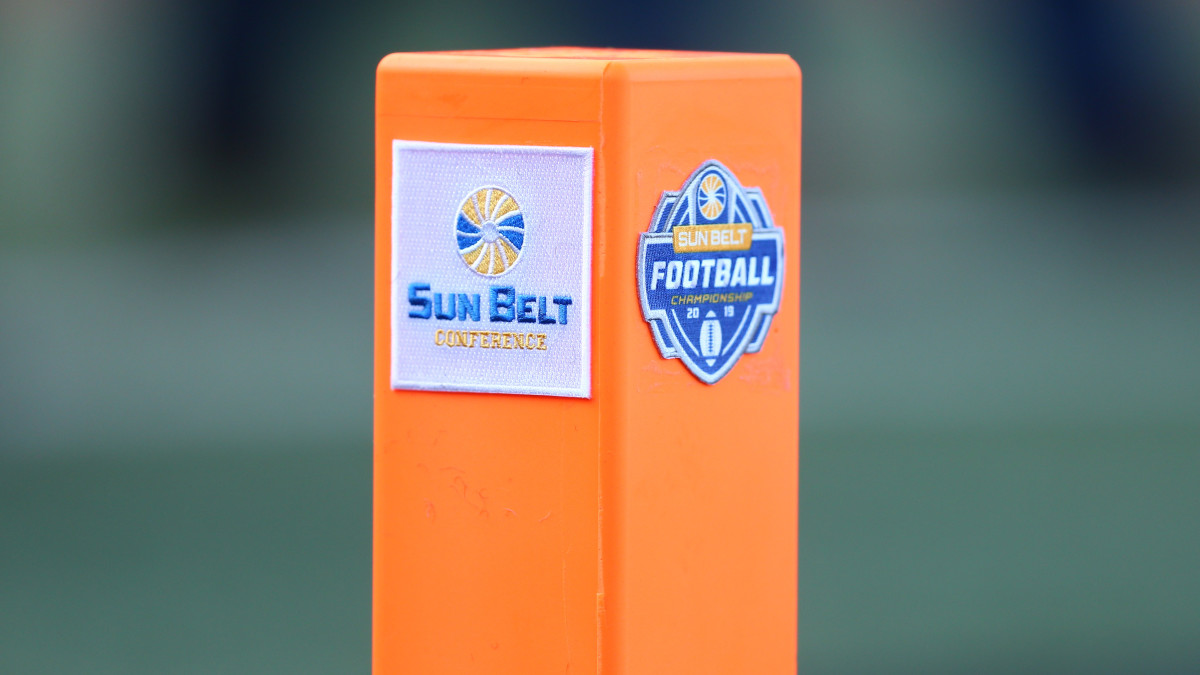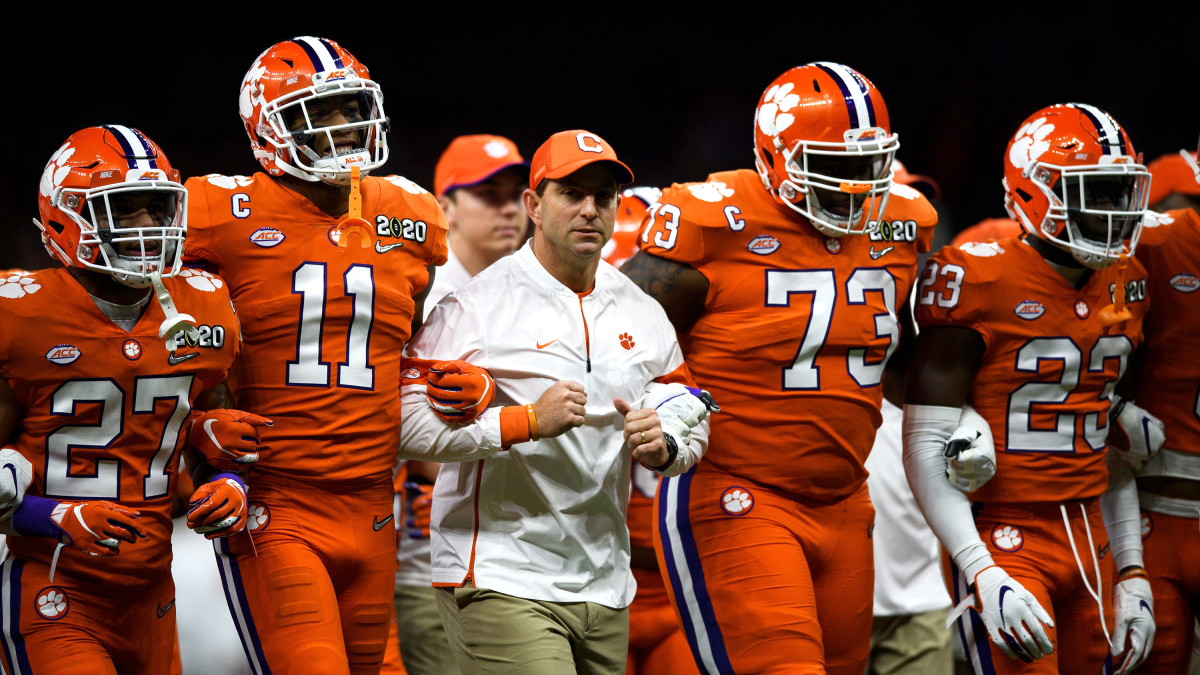As the Season Looms, Where Does Every Football Conference Pushing on Stand?
Call them what you want—the Stubborn Six, the Steadfast Six, the Patient Six—but they represent the last hopes of having a fall college football season.
Midway through August, six of the 10 FBS conferences plan to move forward with having a 2020 fall season: SEC, Big 12, ACC, AAC, Sun Belt and Conference USA. While four of their brethren sideline themselves, the six leagues aren't out of the woods yet. In fact, plenty of obstacles dot their paths, including one of the biggest tests of the pandemic: thousands of students returning to campuses across the country.
Most recently and ominously, North Carolina shut down in-person classes Monday after outbreaks during the first week of class. The UNC athletic department issued a statement saying it intends to continue with its sports teams for now.
Kickoff to the 2020 season is 16 days away. Southern Miss is set to host South Alabama in the earliest scheduled game of this sure-to-be weird season. While all six leagues barrel toward their seasons, each is working independently. They’ve each got their own commissioner who oversees a board of presidents and chancellors, the key group of decision-makers that, more times than not, listens to recommendations from their athletic directors.
Roughly two weeks shy of kickoff, here’s the situation in each of the six conferences:
C-USA
Membership situation: Old Dominion, in C-USA’s Eastern Division, last week became the first member of a conference to bail on a season despite its own conference moving forward. FIU and Rice have both announced a delay to the start of their seasons.
How they got here: The C-USA presidents met late last week with no real decision out of the call except to keep on the path to a 2020 season. They heard from their medical board, specifically getting an update on a hot topic right now in college athletics: lingering heart issues in athletes who have recovered from COVID-19.
What’s in store for this week: C-USA athletic directors meet each Monday and Thursday. It isn’t clear when the next meeting among the presidents will happen. At some point, potentially this week, the league is expected to release a new schedule that recognizes ODU’s absence and could finalize in-season testing protocols.
Outlook on 2020 fall: C-USA, like many Group of Five conferences, is somewhat connected to its Power 5 conference neighbors. In C-USA’s case, that’d be the ACC and SEC. As long as those two are still marching forward, it feels like C-USA will be right behind them. C-USA programs still have four guarantee games on the schedule, and those contests—along with the CFP distribution money—make it worthwhile financially to have a season. That said, the conference is expected to implement a similar in-season testing protocol to its Power 5 brethren, and that means steep prices for programs that have budgets that are one-tenth of the major colleges.
They said it: “Right now, all systems are ‘go.’ Everything is subject to change, but we’re in football mode.” —a conference source

SUN BELT
Membership situation: No schools have backed out of a season just yet.
How they got here: The league has announced that it plans to play the normal eight conference games and its teams are allowed to play up to four non-conference opponents.
What’s in store for this week: Sun Belt presidents are scheduled for a joint call with athletic directors on Wednesday, though there’s no reason to think that any significant decision will emerge from it.
Outlook on 2020 fall: The Sun Belt feels attached to the SEC. If the SEC leaps from a bridge, expect the Sun Belt to follow it. The Sun Belt–SEC relationship is similar to other Group of Five–Power 5 connections, such as Mountain West–Pac-12 and MAC–Big Ten. These conferences are often in lock step with one another, the little brother following the older brother’s path. That said, the Sun Belt’s number of guarantee games (three) against Power 5 teams continues to shrink.
They said it: “It’s still worth it to us to play a season. If we don’t have a season at all, I don’t have the (guarantee) game nor do I have the CFP (money that is distributed throughout the FBS).” —a conference source
SEC
Membership situation: Everyone is on board to continue pursuing a 2020 fall season. And while there have been reported outbreaks at several schools, none of them have paused or suspended workouts this summer, and many of their COVID numbers are leveling off after having their players back for two months.
How they got here: Of all the leagues, the SEC has been the most public about its desire to play this fall—from coaches to administrators to the conference office. The league settled on a 10-game, conference-only schedule a few weeks ago and announced its schedule Monday night.
What’s in store for this week: The SEC presidents have a standing call each Thursday. As of Monday night, no impromptu call was scheduled like last week, when SEC leaders met in light of the Big Ten and Pac-12 news.
Outlook on 2020 fall: As mentioned above, the league is more committed to playing a 2020 fall season more than any other, and it’s not difficult to see why. The SEC’s slogan—“It Just Means More”—applies in this situation. College football’s importance to the South is certainly a motivating factor for the conference. It should be noted that the SEC’s medical advisory panel has not approved for the conference to play a season… yet. For now, the league’s medical experts have only cleared teams to practice. SEC squads started fall camp Monday.
They said it: “We’re trying to create a runway to get this thing off the ground. (The presidents) want to keep moving forward until we can’t move forward anymore.” —a conference source
BIG 12
Membership situation: Everyone is proceeding with plans to play, with most of the league now plotting 25% attendance for home games after many were originally hoping for double that. Oklahoma just lost star running back Kennedy Brooks, who opted out, which makes the transfer of Trey Sermon to Ohio State in the spring a doubly painful loss. After having low numbers all summer, the Sooners also were hit with an uptick in positive cases after giving the team a week off from practice.
How they got here: The Big 12 is the league that saved fall football—for now. When conference presidents and athletic directors heard what they wanted to hear from medical experts regarding the virus and related issues (particularly myocarditis), they decided last week to keep pressing on. That gave the ACC the signal it needed to do the same, and that in turn kept the SEC in the fold.
What’s in store for this week: Big 12 presidents had a previously scheduled call Monday to discuss the season, with no significant news resulting from the call. Athletic directors will convene later this week.
Outlook on 2020 fall: With non-conference games scheduled to start Sept. 12, the season is coming into sharper focus. But last week the state of Kansas added a required 14-day quarantine for anyone who attended a mass gathering involving attendance of more than 500 people outside the state—a rule that could create problems for both Kansas and Kansas State, and their opponents, if it stays on the books.
They said it: “When the medical people got all the presidents on the same page, it cleared up a lot of things for us. We were ready to proceed after that.” —league source

ACC
Membership situation: Everyone is proceeding with practice, but the wide variance in geography corresponds with a wide variance in outlooks. In the Northeast, Boston College and Syracuse are both are in states that have travel restrictions on the books.
How they got here: The ACC waited to gauge the commitment level of the Big 12 last week before making its own commitment to stay in the game alongside the SEC. With a majority of the Power 5 leagues still going forward, the ACC was comfortable with the strength in numbers. “I do believe you can sufficiently mitigate the risk of bringing COVID onto the football field or into the training room at a level that’s no different than living as a student on campus,” Dr. Cameron Wolfe of Duke, who chairs the ACC medical advisory team, told Sports Business Daily.
What’s in store for this week: There is a regular Wednesday presidents’ meeting, plus an array of league calls for athletic staffers. There are expected updates from each school on how the return of students to campus has been going. North Carolina’s situation in particular will likely be a topic of conversation.
Outlook on 2020 fall: This is the most fickle of the three Power 5 conferences still planning to play, so any further Carolina-level disruptions among the student body could be a challenge to the ACC’s willingness to keep going. For now, ACC kickoff is set for Sept. 10, with UAB visiting Miami. The ACC format calls for 10 league games and one non-conference opponent, and that game must be played within the home state of the ACC team. All non-conference opponents have been set except Clemson’s (which is expected to be The Citadel). Both Syracuse and North Carolina State have voiced testing concerns regarding non-league opponent Liberty. With Notre Dame playing a full ACC slate for the first time, the season takes on added luster.
They said it: “If anything, you can argue that it puts their football team in a safer environment.” —a league source about UNC going to online classes only, reducing on-campus student interaction
AAC
Membership situation: The schools are all in, for now.
How they got here: AAC presidents met last week and agreed to continue with progress toward a 2020 season. They’ve announced a scheduling philosophy of eight conference games plus as many as four non-conference games. Meanwhile, Tulsa has paused workouts after eight players tested positive and eight more are quarantined via contact tracing.
What’s in store for this week: AAC presidents are meeting Tuesday in a joint call with athletic directors. The group is expected to hear a briefing from its medical panel in light of concerns raised last week from the Big Ten and Pac-12, specifically regarding COVID-19’s impact on the heart.
Outlook on 2020 fall: League presidents have some health concerns after the Big Ten and Pac-12 bailed. Those concerns will be addressed during the medical briefing Tuesday. Administrators around the league don’t necessarily expect a vote or determination from the meeting, but the call is an important step at a critical time. The AAC opens the season Sept. 5. The AAC likes to call itself the sixth conference in the “Power 6.” As a sign of strength, many officials around the league feel like the AAC will hang around as long as the Power 5 conferences do.
They said it: “We don’t have another month like the SEC. It feels like now is the time you’ve got to commit one way or the other.” —a conference source
More From SI.com Team Sites:
Will the Big Ten Reconsider? Unlikely, Penn State's AD Says
Why the SEC Is in No Rush to Cancel the Season
Swinney and Venables: Freshmen Are 'Better than Advertised'
